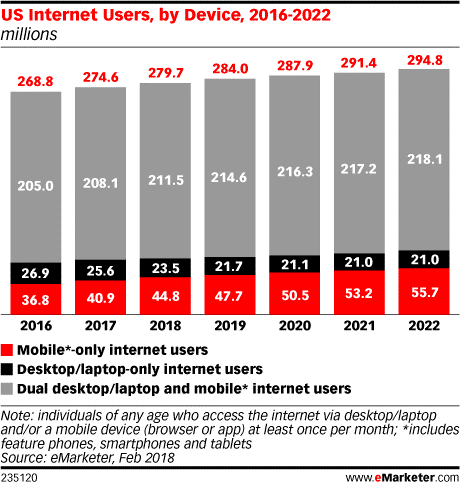Mobile has dominated the conversation, and the marketing strategy, of advertisers and marketers alike for the past few years. With smartphone user rates posting impressive growth numbers year-over-year, leading brands have given mobile a larger portion of their marketing investment – some even taking a ‘mobile-first’ approach when it comes to their marketing mix. The heavy focus on mobile is for good reason, mobile users are loyal to their smartphones. However, recent studies have shown that mobile adoption growth is actually declining. In 2017, smartphone user growth was down YOY at 6.1% vs. 8.7% in 2016. It is estimated by 2020, growth will drop all the way to 2.0%. Should brands that have invested significantly in mobile be worried about this slow down? Not at all.
This lull in adoption isn’t due to a decreased interest in smartphones, but because penetration has reached capacity for the majority of U.S. consumers. In fact, only senior citizens (age 65+) will see double-digit growth in smartphone use this year1.
With smartphone makers, like Apple and Samsung, producing lower cost options (iPhone C series) and cell phone carriers offering low cost or free smartphones on upgrades, switches, and new lines, it’s not hard to see why smartphones have reached near mass capacity. This trend is also influenced by smartphone markers surpassing the ‘perceived value’ of the devices – many with relatively short lifespans, cumbersome features, and disruptive bugs. This very well may drive consumers towards adopting lower-cost devices or simply not replacing their current device until absolutely necessary, slowing growth rates.
Much like the inflection point that occurred with the web, we are now seeing this same phenomenon with smartphones. However, as seen in the eMarketer chart, growth rates are slipping but smartphone user numbers are still climbing. This means that consumers are still holding on tightly to their smartphones. The bigger picture is that now that smartphones have reached the broadest number of people, marketers should be optimizing their mix to include mobile, if they haven’t already. If they already are, they should be looking at how to optimize their campaigns to link mobile with their other channels and provide a truly outstanding customer experience. In many cases, even leading brands are simply not ready for their customers to purchase on mobile, which can lead to a subpar customer experience and even a loss of customers.
In a recent survey, it was discovered that 37% of U.S. consumers would be happy to pay more for a product or service if the mobile shopping experience was better.2 This number becomes even more significant when you look specifically at U.S. millennials, where nearly half (44%) are willing to reward brands that provide a ‘five-star’ service.2
The data supports this ‘multi’ or ‘omni’ channel approach – a recent eMarketer study stated that approximately 83.0% of internet users will use a mobile phone to go online. The results also show that desktops/laptops are still widely used, as 84.0% of digital users are expected to use them to visit the web this year. For those that put all their eggs in the mobile basket, only 16% of users will exclusively use a mobile device for internet access.1
Being able to connect the dots across the entire customer journey with Visitor Stitching is critical to providing the best customer experience possible and the foundational element for enabling Digital Transformation. The cross-device behaviors of your customers will tell you a lot about who they are, what they do, and what they care about. Brands should be focusing on not only connecting datasets to drive more personalized and efficient experiences; but also producing real business results based off of a total 360 view.
Sources:



